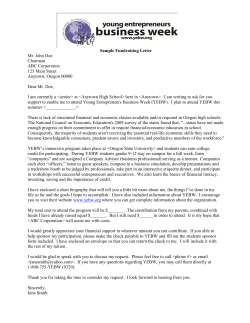
Unmanned Systems Research - Blogs
THE OREGON STATE UNIVERSITY ADVANTAGE Unmanned Systems AIR LAND SEA Oregon State faculty members are using aerial, land-based and on-water/underwater unmanned systems in their research. The applications span several market sectors: precision agriculture, geomatics and surveying, geology, ocean and atmospheric science, forestry, robotics, environmental monitoring and remote sensing. Unmanned systems are a new platform for innovation and commercial activity, as well as a research tool. Oregon State is a member of the Pan-Pacific Unmanned Aerial Systems (UAS) Test Range Complex, one of six FAA-approved test range areas. This participation provides unique capabilities for testing UAS in a variety of applications. Oregon State has more than 30 active FAA certificates of authorization to conduct UAS test flights. As part of this growing industry in the Pacific Northwest, Oregon State will have many opportunities to establish itself as a center of unmanned systems science, research and commercialization. The Autonomous Systems Research Group (ASRG) was established by Oregon State to support faculty research and economic development by connecting industry, state and federal interests in unmanned systems with OSU expertise, students, labs and resources. Partner with Oregon State Oregon State is actively looking for collaborations with government agencies, universities, business and industry to advance unmanned systems. Consider Oregon State as a trusted research partner — a resource for talented faculty and students and technological innovation. Contact: Ann Schmierer, Ph.D. | Director of Industry Partnering | OSU Advantage Partnerships Office: 541-737-1180 | Cell: 541-609-8900 | Email: ann.schmierer@oregonstate.edu research.oregonstate.edu research.oregonstate.edu/unmanned-systems-initiative advantage.oregonstate.edu THE OREGON STATE UNIVERSITY ADVANTAGE Unmanned Systems Projects Robotics Robotics • Core faculty from Mechanical Engineering, Computer Science and Electrical and Computer Engineering. • Collaborative research in oceanography, forestry, agriculture, spanning air, land and sea unmanned systems. Unmanned Vehicles • Focus areas include actuation, locomotion, manipulation, dynamics, control, sensing, artificial intelligence and human/robot interaction. OSU Data Analytics • ATRIAS robot live demonstration: Hurst Dynamic Robotics Laboratory DARPA Robotics Challenge June 5-6, 2015, Pomona, California Sensing internet of things Sensing Oregon State has a long legacy of remote sensing capabilities that are now being integrated into research with unmanned systems. Applications are very broad: • Geotechnical and infrastructure monitoring and geomatics. • Climate change impacts on water resources, forest and shorelands. • Management and optimization of agricultural production. • Measurement of atmospheric temperatures with fiber optic thermometers suspended from unmanned aircraft, Selker and Wing. • Use of multispectral camera sensing from UAVs for farming, collaboration with OSU Hermiston Agricultural Research and Extension Center, Boeing and USDA. Oregon State is expanding the opportunities and tackling the challenges of creating integrated solutions in IoT. R&D span all aspects of sensory systems, IoT systems, software systems and infrastructure, data intelligence and visualization and security. IoT Test and Compatibility Lab: product testing, implementation, software engineering, hosting at the Center for Applied Systems and Software, Jensen. Autonomous Systems @ OSU Artificial Intelligence, Machine Learning and Data Science Group works to combine knowledge from database, machine learning, information retrieval, networking and human-computer interaction research to create more intelligent information systems, School of Electrical Engineering and Computer Science. Unmanned Aerial Vehicles Internet of Things Save the date: Data Analytics The PRISM Climate Group gathers climate observations from a wide range of monitoring networks, applies sophisticated quality control measures and develops spatial climate datasets and modeling techniques to reveal short- and long-term climate patterns from 1895 to the present. June 30, 2015 10 a.m. to 3 p.m. CH2M HILL Alumni Center Corvallis, Oregon The Robotic Decision Making Laboratory performs fundamental research in robotic systems, such as multi-goal path planning for autonomous data collection and using undersea gliders with acoustics to track marine animals, Hollinger. The Aerial Information Systems Laboratory conducts research in the use and development of UAS for remote sensing. Active COAs for forestry, agriculture, fish and wildlife and search-and-rescue operations, Wing. Join us for this inaugural event to learn more about Oregon State research and opportunities for collaboration. blogs.oregonstate.edu/autonomoussystems
© Copyright 2025













